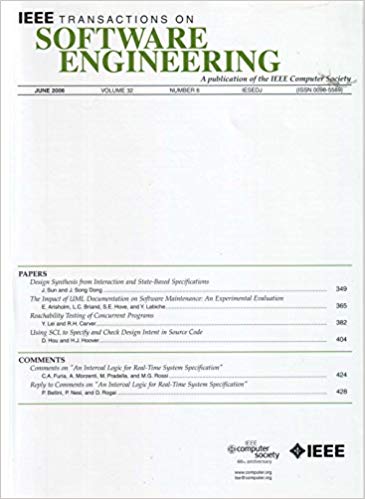面向自动程序修复的大型代码语言模型的全面微调
IF 6.5
1区 计算机科学
Q1 COMPUTER SCIENCE, SOFTWARE ENGINEERING
引用次数: 0
摘要
自动化程序修复(Automated program repair, APR)研究已经进入了大语言模型(large language models, LLM)的时代,研究者们已经进行了一些实证研究来探索LLM对APR的修复能力。许多研究采用了零/少次学习范式来研究APR,即直接使用LLM来生成给定其周围环境的可能正确的代码。虽然有效,但基于微调范式的llm修复能力尚未得到广泛探索。此外,llm是否有潜力修复更复杂的错误(例如,多块错误)仍然是未知的。为了填补这一空白,在这项工作的会议版本中,我们在微调范式中对百万级llm的程序修复能力进行了初步研究。我们选择了5个流行的百万级llm,具有代表性的预训练架构,包括CodeBERT, GraphCodeBERT, PLBART, CodeT5和UniXcoder。我们考虑3种典型的程序修复场景(即,bug,漏洞和错误),涉及3种编程语言(即,Java, C/ c++和JavaScript)。我们的实验结果表明,微调这些llm可以显著优于以前最先进的APR工具。然而,数十亿级llm对APR的修复能力在很大程度上仍未被探索。此外,它们庞大的模型尺寸显著增加了微调的计算成本。虽然参数有效微调(PEFT)技术提供了一个很有前途的解决方案,但它们在修复任务和适当的PEFT策略选择方面的有效性尚不清楚。同样,许多新的APR策略也被用于非预训练模型,但它们在llm上的适用性和有效性仍未得到检验。为了解决这些差距,我们通过三个关键维度扩展了我们之前的研究:1)LLM4APR,它评估了50亿个级别的LLM家族(InCoder, CodeGeeX, CodeGen, StarCoder和CodeLlama)在精细调整范式下的修复能力;2) PEFT4LLM,将全参数微调(FPFT)与三种PEFT技术(LoRA、AdaLoRA和IA3)进行比较,以确定平衡llm修复成本和性能的最佳策略;3) APR4LLM,研究基本神经机器翻译(NMT)方法与三种高级修复策略(TENURE, ITER和KATANA)的潜力,以增强llm的修复能力。总的来说,我们广泛的结果表明,较大比例的模型通常具有更好的修复能力。LoRA技术仍然是LLM4APR研究的最佳选择。不同的修复策略导致基础模型的修复能力不同,但一些在非预训练模型上表现良好的策略在llm上并没有表现出优势。此外,我们发布了所有微调了修复任务的llm,以方便LLM4APR的研究,并鼓励研究人员在这些修复llm的基础上开发更强大的APR工具。本文章由计算机程序翻译,如有差异,请以英文原文为准。
Comprehensive Fine-Tuning Large Language Models of Code for Automated Program Repair
Automated program repair (APR) research has entered the era of large language models (LLM), and researchers have conducted several empirical studies to explore the repair capabilities of LLMs for APR. Many studies adopt the zero/few-shot learning paradigm for APR, which directly use LLMs to generate the possibly correct code given its surrounding context. Though effective, the repair capabilities of LLMs based on the fine-tuning paradigm have yet to be extensively explored. Also, it remains unknown whether LLMs have the potential to repair more complicated bugs (e.g., multi-hunk bugs). To fill the gap, in the conference version of this work, we conduct an initial study on the program repair capability of million-level LLMs in the fine-tuning paradigm. We select 5 popular million-level LLMs with representative pre-training architectures, including CodeBERT, GraphCodeBERT, PLBART, CodeT5, and UniXcoder. We consider 3 typical program repair scenarios (i.e., bugs, vulnerabilities, and errors) involving 3 programming languages (i.e., Java, C/C++, and JavaScript). Our experimental results show that fine-tuning these LLMs can significantly outperform previous state-of-the-art APR tools. However, the repair capabilities of billion-level LLMs for APR remain largely unexplored. Moreover, their substantial model sizes significantly increase the computational cost of fine-tuning. While parameter-efficient fine-tuning (PEFT) techniques offer a promising solution, their effectiveness in repair tasks and the selection of appropriate PEFT strategies remain unclear. Similarly, many novel APR strategies have been developed for non-pre-trained models, yet their applicability and effectiveness on LLMs are still unexamined. To address these gaps, we extend our prior study through three key dimensions: 1) LLM4APR, which evaluates the repair capabilities of five billion-level LLM families (InCoder, CodeGeeX, CodeGen, StarCoder, and CodeLlama) under the fine-tuning paradigm; 2) PEFT4LLM, which compares full-parameter fine-tuning (FPFT) with three PEFT techniques (LoRA, AdaLoRA, and IA3) to determine optimal strategies that balance repair cost and performance of LLMs; and 3) APR4LLM, which investigates the potential of a basic neural machine translation (NMT) approach alongside three advanced repair strategies (TENURE, ITER, and KATANA) to enhance the repair capabilities of LLMs. Overall, our extensive results suggest that larger scale models typically have better repair capabilities. The LoRA technique is still the best choice for LLM4APR studies. Different repair strategies result in different repair capabilities for the foundation models, but some of the strategies that performed well on the non-pre-trained model did not show an advantage on LLMs. Besides, we released all LLMs fine-tuned with repair tasks to facilitate LLM4APR research, and we encourage researchers to develop more powerful APR tools on the basis of these repair LLMs.
求助全文
通过发布文献求助,成功后即可免费获取论文全文。
去求助
来源期刊

IEEE Transactions on Software Engineering
工程技术-工程:电子与电气
CiteScore
9.70
自引率
10.80%
发文量
724
审稿时长
6 months
期刊介绍:
IEEE Transactions on Software Engineering seeks contributions comprising well-defined theoretical results and empirical studies with potential impacts on software construction, analysis, or management. The scope of this Transactions extends from fundamental mechanisms to the development of principles and their application in specific environments. Specific topic areas include:
a) Development and maintenance methods and models: Techniques and principles for specifying, designing, and implementing software systems, encompassing notations and process models.
b) Assessment methods: Software tests, validation, reliability models, test and diagnosis procedures, software redundancy, design for error control, and measurements and evaluation of process and product aspects.
c) Software project management: Productivity factors, cost models, schedule and organizational issues, and standards.
d) Tools and environments: Specific tools, integrated tool environments, associated architectures, databases, and parallel and distributed processing issues.
e) System issues: Hardware-software trade-offs.
f) State-of-the-art surveys: Syntheses and comprehensive reviews of the historical development within specific areas of interest.
 求助内容:
求助内容: 应助结果提醒方式:
应助结果提醒方式:


